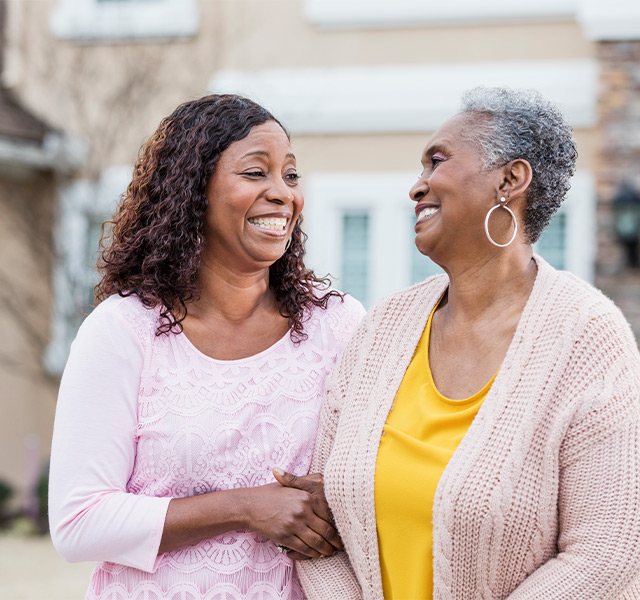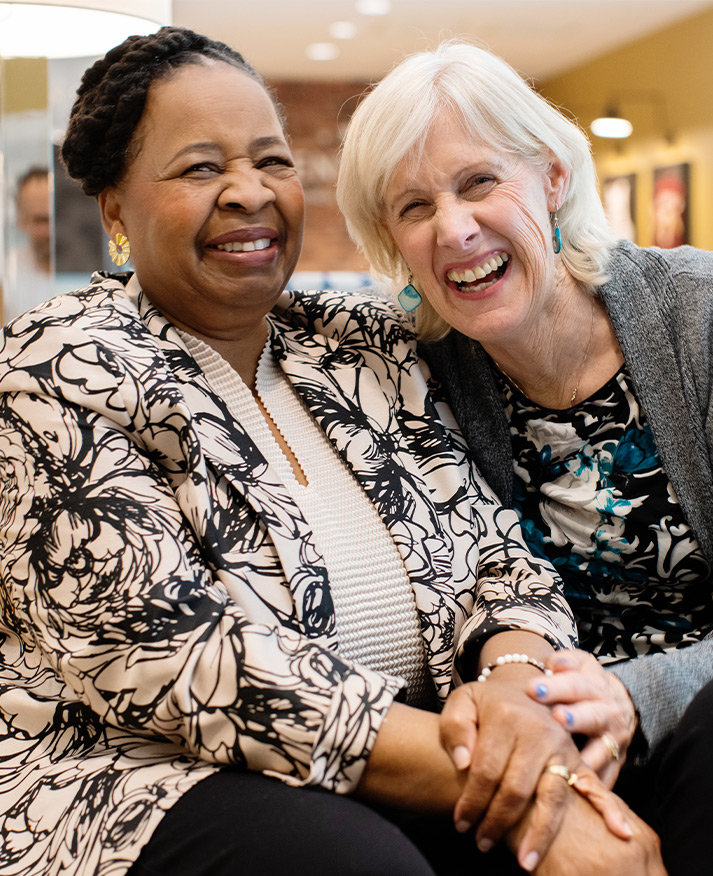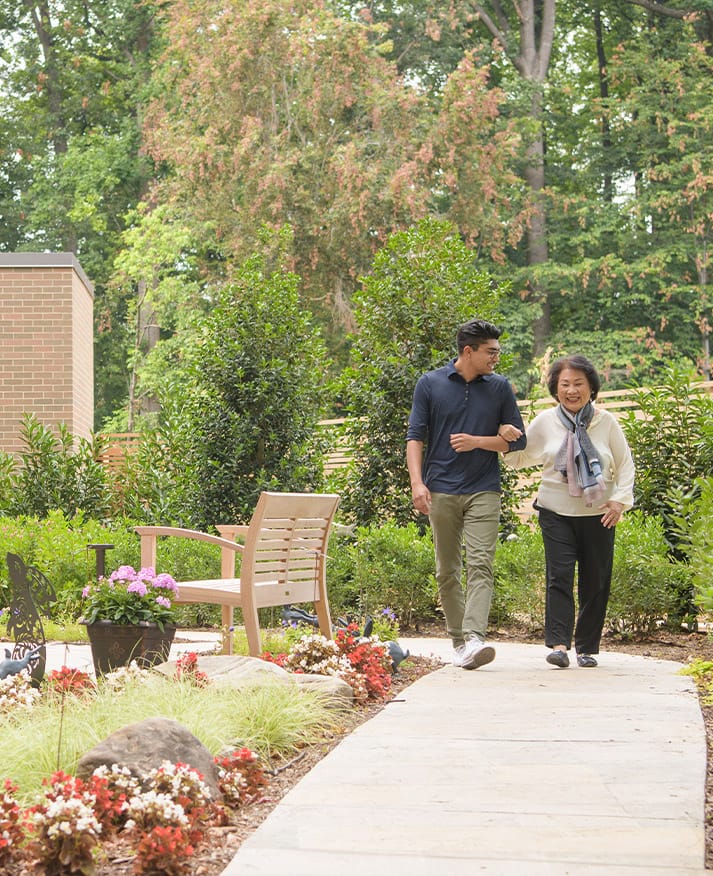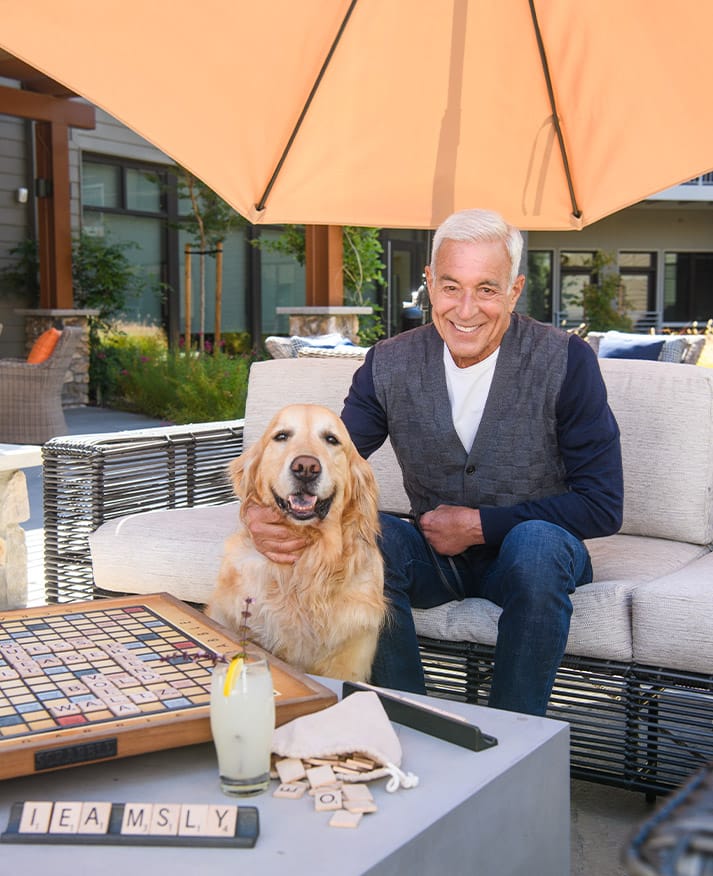How Long Does It Take To Adjust to a Senior Living Community?

Making the move to a senior living community is a major life transition. For many older adults and their families, it’s filled with a mix of emotions, such as relief, uncertainty, hope, and even grief. Whether the move was planned well in advance or prompted by a health event, one common question arises: How long will it take to feel at home in this new place?
At Watermark Retirement Communities, we’ve walked alongside thousands of residents during this time of change. What we’ve learned is clear: adjusting to senior living is a process, not a moment. With the proper support and mindset, this journey can lead not only to comfort but to a renewed sense of purpose, connection, and joy.
In this blog post, we’ll share:
- What the research says about the average adjustment timeline,
- Factors that influence how quickly someone adapts,
- Realistic expectations for the first year, and
- Ways to support your loved one — or yourself — during this transition.
Let’s explore how the journey unfolds and how to make the most of each stage.
What the Research Says About Adjustment Timelines
There’s no single answer to how long it takes to adjust to a senior living community, but evidence-based research gives us helpful benchmarks.
- A typical range is 3 to 6 months. Some industry experts suggest that most older adults begin to feel moderately adjusted within this time frame.
- For some, it can take up to a year. One study found that full emotional and psychological adaptation often unfolds gradually over the course of 5–12 months.
- The adjustment timeline is highly individual. Factors such as physical health, personality, previous living situation, and family involvement can all influence the pace of adaptation.
The process of adapting has also been shown to follow specific emotional and behavioral patterns, sometimes referred to as a three-phase model:
- Initial Orientation (Weeks 1–4): Residents learn routines, meet staff, and manage the emotions of change.
- Adaptation (Months 2–6): New relationships form, routines become familiar, and independence is rebuilt.
- Integration (Months 6–12): A deeper sense of belonging, comfort, and purpose emerges as the new community feels like home.
These phases aren’t rigid, but they offer a helpful road map for what many residents experience.
The Emotional Journey: Understanding the Phases of Adjustment
Let’s take a closer look at what each phase typically involves. While every individual’s journey is different, understanding the emotional patterns that often emerge can help families recognize progress and know when extra support may be needed.
Weeks 1–4: Orientation and Emotional Disruption
The early weeks can be emotionally complex. Even in a beautiful, supportive setting, it’s natural for residents to experience sadness, disorientation, or anxiety.
Common experiences during this phase can include the following:
- Grief over leaving a previous home or community,
- Feelings of loneliness or isolation,
- Anxiety about unfamiliar routines or surroundings, and
- Sleep disruptions or changes in appetite.
According to psychological studies, loss of control and sudden environmental change can trigger a response similar to relocation stress syndrome (RSS). While not experienced by everyone, RSS can lead to depressive symptoms or confusion in the early weeks of a move.
Families should be aware of these potential responses and help normalize them. Open conversations, validation of feelings, and shared experiences can ease the emotional weight of this first phase. At Watermark communities, our associates are trained to support new residents emotionally as well as logistically, ensuring they are seen, heard, and cared for.
Months 2–6: Building Routine and Relationships
This phase is often when the adjustment begins to feel real. Residents start to participate more fully in daily life, from dining programs to fitness classes. New friendships may start to blossom, and familiar faces become comforting.
Positive signs of progress can include any of the following:
- Participation in community events or group meals,
- Forming a connection with staff or neighbors,
- Feeling more confident about the daily routine, and
- Reclaiming a sense of independence and identity.
This stage is all about engagement. When residents begin making decisions about how they want to spend their days, which activities to participate in, and whom to spend time with, they’re reclaiming a sense of control. Purposeful activities, such as volunteering, creative expression, mentorship, or simply showing up for a neighbor, help reinforce a sense of value and belonging.
Many senior living communities have internal programs designed to empower residents to pursue passions and share their knowledge, deepening community connections. At Watermark, we’ve seen residents flourish by leading a weekly cooking demo, forming book clubs, or mentoring peers. This kind of involvement can accelerate emotional comfort.
Months 6–12: Deepening Comfort and Belonging
By the second half of the first year, many residents feel at ease. Their apartments reflect their personality. They have favorite seats in the dining room, go-to walking routes, and people they greet by name.
Signs of successful adjustment may include:
- Describing the community as “home,”
- Participation in activities for enjoyment (not just structure),
- Advocacy or volunteering within the community, and
- A renewed sense of meaning or purpose.
In this phase, some residents begin taking on leadership roles. They may welcome new arrivals, join community advisory boards, or initiate traditions that reflect the community’s shared values. The goal is no longer just feeling settled; it’s about thriving.
For others, adjustment may remain a work in progress. That’s okay. The support continues. At Watermark, we meet residents where they are, not where we expect them to be. Our associates are trained to spot subtle signs of lingering grief or hesitation and respond with empathy, encouragement, and tailored support.
Factors That Influence the Adjustment Period of Transitioning to a Senior Living Community
While the 3–6 month timeline is typical for some seniors, the actual pace of adjustment depends on several interrelated factors.
1. Autonomy and Decision-Making
Older adults who actively participate in the decision to move may experience a faster and more positive adjustment. When residents feel ownership over their space, schedule, and social life, they are more likely to view the move as a positive change.
One way families can support this autonomy is by involving loved ones early in the search process, encouraging them to tour communities, ask questions, and share concerns. After move-in, continuing to respect their preferences, such as meal choices, daily schedules, and privacy, helps build confidence.
2. Personality and Coping Style
Those with flexible, optimistic mindsets tend to adapt more quickly. But that doesn’t mean those who struggle early on can’t thrive later, especially when offered emotional support and reassurance.
Residents who have dealt with previous life transitions successfully often draw on that experience. Those with rigid routines or past traumas may need more time and compassion to settle in. Staff training in trauma-informed care can help ensure no one is left behind.
3. Social Support and Connection
A strong social network, whether it’s friends from outside the community, close family members, or new acquaintances, can ease the transition. Isolation is a risk factor for delayed adjustment.
Families can encourage socialization by learning about local events and interest groups and inviting their loved one to explore them. Visiting during a class or holiday event can also reinforce the joy of shared experience.
4. Health and Cognitive Status
Health conditions or memory impairments can complicate the transition. Individuals living with dementia may benefit from additional support, consistency, and familiar routines. Memory Care neighborhoods at Watermark are designed with these needs in mind, featuring calming environments, sensory cues, and therapeutic programming that promotes comfort and confidence.
Physical health also plays a role. Residents who are recovering from hospitalization or chronic illness may need more time to feel their best. Ensuring that medical needs are met and rehab or fitness support is in place helps ease this burden.
5. Community Culture and Staff Engagement
Warm, welcoming environments and attentive team members make a profound difference. When residents are greeted by name and encouraged to participate in ways that match their interests, they tend to feel at home more quickly.
Community culture is often intangible but incredibly powerful. It’s reflected in the way neighbors look out for one another, how leadership responds to feedback, and how inclusive the programming feels. At Watermark, we take pride in cultivating a culture of respect, hospitality, and joy.
What Makes Watermark Communities Different?
At Watermark’s senior living communities, a successful transition starts long before move-in day and continues long after the last box is unpacked.
Here are a few of the ways we support each resident’s journey:
- Pre-arrival planning with customized transition plans;
- Resident Ambassadors to provide peer-to-peer connection;
- Flexible activity calendars that reflect individual interests and energy levels;
- On-site support teams that include wellness experts, memory care specialists, and engagement professionals; and
- Family involvement through welcome events and regular communication.
Every community also provides ongoing education and professional development opportunities through Watermark University, giving residents the chance to explore new subjects, revisit old passions, and engage with fellow learners. Whether someone wants to try tai chi, teach watercolor painting, or attend a seminar on local history, they’ll find meaningful experiences that inspire.
Our associates take the time to build personal connections with each resident, learning about their preferences, background, and goals. Through thoughtful training in topics like trauma-informed care and dementia communication, team members are equipped to provide support that goes beyond logistics, fostering a genuine sense of trust and belonging. Our goal isn’t just helping residents adjust; it’s helping them thrive.

The Family’s Journey: What To Expect as a Loved One Adjusts
While your loved one is navigating a new chapter in senior living, you’re likely going through your own transition, too. It’s entirely normal for family members to feel a mix of emotions, including relief, uncertainty, hope, and even guilt, as routines change and caregiving roles evolve.
In the early weeks, you may find yourself constantly checking in, wondering if they’re eating well or making friends. You might second-guess the decision, especially if your loved one expresses discomfort or frustration. These feelings are part of your own adjustment process.
It’s important to give yourself grace. Your continued involvement, even if it looks different than before, is still deeply meaningful. Many family members discover a new way to connect, one rooted less in daily caregiving tasks and more in emotional support, encouragement, and shared joy.
The community you choose should support this transition, not just for residents, but for their families too. Look for a team that communicates openly, encourages family participation, and provides resources like support groups, education sessions, or family welcome events.
At Watermark, we recognize that family support is vital to every successful transition, and we’re committed to walking alongside you every step of the way.
Tips for Families: Supporting a Loved One’s Transition

Family involvement is a critical part of the adjustment process. Here’s how you can help:
- Stay connected but allow space. Frequent visits or calls are comforting, but it’s also important to give your loved one time to develop their own routine.
- Encourage participation, even in small ways. Help them explore new hobbies or join group meals.
- Bring the familiar. Photos, artwork, or a favorite chair can help the new space feel like home.
- Check in with staff. Partner with the community’s team to monitor progress and flag concerns early.
- Be patient and compassionate. Everyone adjusts at their own pace.
Additionally, consider joining family programs or support groups offered by the community. These groups offer a safe place to ask questions, share concerns, and connect with other families on similar journeys.
When Adjustment Takes Longer Than Expected

Some residents may take longer to feel comfortable. That’s okay, and it doesn’t mean the move was a mistake.
If your loved one seems withdrawn, depressed, or distressed for more than a few months, talk with the community’s care team. Support options may include:
- Emotional wellness visits,
- Grief counseling,
- Adjustments to medication or routine, and
- Additional peer or staff support.
In some cases, working with a licensed therapist or elder care counselor can help identify barriers to adjustment and create a road map for support. At Watermark, our care teams work closely with residents and families to ensure no one walks this journey alone.
Frequently Asked Questions About Adjusting to Senior Living
Families considering a move to senior living often have questions about what the adjustment process looks like and how to support their loved one along the way. Here are answers to some of the most common concerns.
Most new residents begin to feel more comfortable within 3 to 6 months of moving into a senior living community. Full emotional adjustment may take closer to a year, depending on the person’s health, personality, and level of support. While each journey is unique, patience, social connection, and compassionate care all help make the transition smoother.
Positive signs include participating in activities, forming friendships, and referring to the community as “home.” If your loved one seems more relaxed, engaged, and confident in their daily routine, it often means they’re finding their footing. You may also notice improved sleep, appetite, and overall mood.
If your loved one seems withdrawn, anxious, or uninterested in their surroundings after the first several weeks, it could be a sign they’re having trouble adjusting. Other red flags include avoiding meals or activities, expressing persistent sadness or frustration, changes in sleep or hygiene, or repeatedly asking to leave. While some emotional ups and downs are normal, ongoing distress should be shared with the community’s care team to explore supportive options.
Some individuals take longer to adjust than others, and that’s completely normal. If your loved one is still struggling after a few months, speak with the care team. Additional support, like emotional wellness programs or personalized engagement plans, can make a meaningful difference.
Relocation Stress Syndrome (RSS), sometimes called transfer trauma, is a condition that can affect older adults after a major move, like transitioning to senior living. It may cause symptoms such as confusion, sadness, anxiety, trouble sleeping, or withdrawal.
RSS is more likely to occur when a move happens suddenly or without the resident’s input, but it’s not uncommon even in well-planned transitions. With the proper emotional support and consistent routines, most symptoms improve over time.
Yes, but they may need more time and specialized support. Individuals living with Alzheimer’s or other forms of dementia benefit from memory care environments designed for consistency, sensory engagement, and gentle routines. These communities help residents feel safe, understood, and more connected.
Stay connected, bring familiar belongings, and encourage participation in community life. Avoid rushing the process because adjustment takes time. Be present, patient, and proactive. At Watermark, many communities also offer family welcome events and regular updates to keep loved ones involved throughout the journey.
Our approach is rooted in personalized transitions. From pre-move planning to ongoing emotional support, we meet each resident where they are. Programs like Watermark University, our Resident Ambassador program, and our friendly associates help make new communities feel like home, faster and more completely.
Finding Comfort in a Senior Living Transition, One Step at a Time
Adjusting to senior living isn’t always easy, but with the proper support, it’s absolutely possible. For most residents, the first few months are filled with small victories: learning a new routine, making new friends, and rediscovering a sense of purpose.
At Watermark, we walk beside each resident and family member during this transition, offering compassion, connection, and care every step of the way. If you or a loved one is preparing for this next chapter, we’re here to help make the move feel more like a new beginning.
Reach out to your nearest Watermark community and learn more about how we support residents and families through every stage of the transition.


